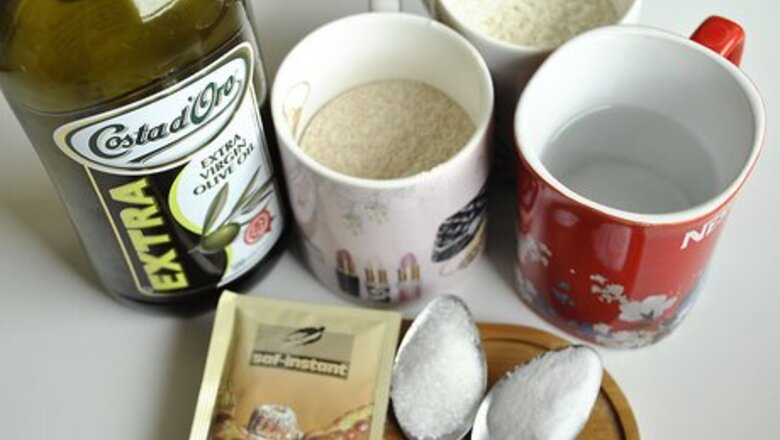
views
Making Whole Wheat Crust
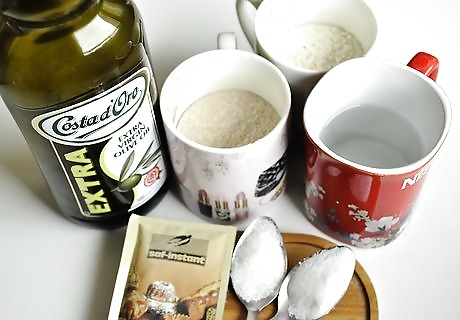
Gather the ingredients for the whole wheat dough. Whole wheat dough contains more fiber than dough made with white flour. It is simply healthier for you. The extra fiber in the whole wheat dough helps with digestion. You can make your whole wheat dough, or you can find it pre-made in many grocery stores. Most whole-wheat pizza dough recipes call for these ingredients: Whole wheat flour, yeast, water, salt, oil, and occasionally sugar. Some dough also requires hot water, all-purpose flour, and extra virgin olive oil. The olive oil and sugar make the dough more tender. Avoid pre-made dough that contains trans fat, though. Check the label.
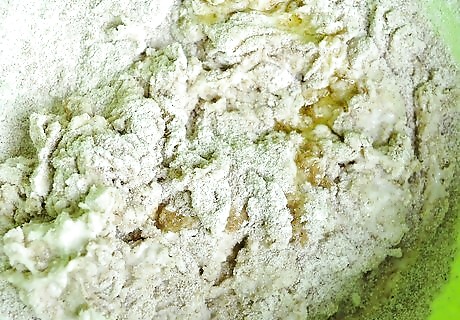
Combine the ingredients. Put 3/4 cup of whole-wheat flour, 3/4 cup of all-purpose flour, one package of quick-rising yeast, one teaspoon salt, and 1/2 teaspoon sugar in a food processor. Mix the ingredients by pulsing them together. Next, mix 1/2 cup of hot water with one tablespoon of extra virgin olive oil. Pour the liquid mixture into the food processor and mix until the dough holds together. Add a little more warm water if it seems dry. Add a little more flour if it seems too sticky. Form the dough into a ball. The second version of this recipe calls for you to mix one teaspoon of active dry yeast, 3/4 cup plus two tablespoons of warm water, and one teaspoon of honey. Mix them in a bowl, and let them sit for up to 5 minutes until you see a layer of foam. Whisk two cups of white whole wheat flour with 1/2 teaspoon salt. Add the yeast mixture to it, along with a tablespoon of extra virgin olive oil.
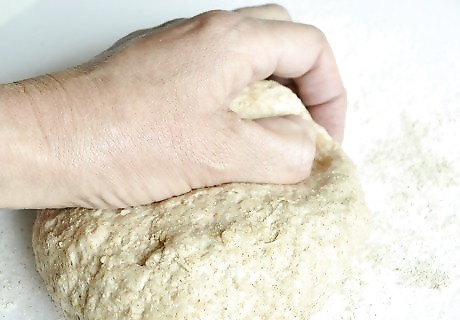
Dust surfaces with flour. Put the dough on a surface that you dust with flour. This is important, so the dough doesn't stick to the surface. Now, you will be ready to knead the dough. To knead the dough, also, dust the dough itself with flour to reduce stickiness. You've used enough flour when the dough bounces back when you put your finger on it. Put the ball of dough on the surface, and fold it in half. Then use the heels of your hands to push into the dough. Turn the dough by a quarter and repeat for 6-10 minutes. Whole wheat dough has less volume, not rising as much as other kinds of pizza dough. Handle the dough more lightly when kneading it, so it doesn't break. The dough won't stretch as easily without tearing. You could add a little white flour to it to make it easier to work with. Cover the dough with waxed paper that you have sprayed with cooking spray. Place the sprayed side of the paper against the dough. Let the dough sit for about 20 minutes. For the second recipe, cover the dough with plastic wrap, and let it sit for 2 hours. It's done when it's doubled in size.
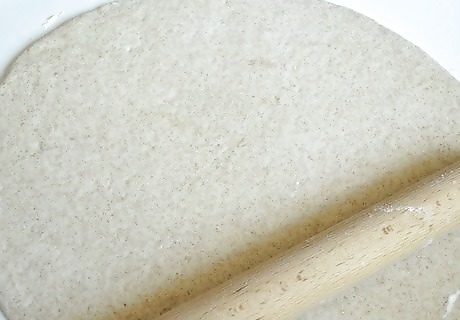
Roll the dough. Roll out the dough using either a rolling pin or your hand. A 13-inch circle is recommended. Shaping the dough by hand will create a crust that is less dense than using a rolling pin. To roll out the dough by hand, dust your fingers with flour. Take the ball of dough and shape it into a circle with your fingers. Start in the middle of the circle, and press the dough outward, while spreading your fingers out, to widen the disc's size. Then, lift the dough, putting your fingers on the edges of the circle. It's more important to have an even thickness throughout the dough than to accomplish a perfect circle. Roll the dough as thin as you can. Brush olive oil on the dough when done.
Trying Alternatives to Dough
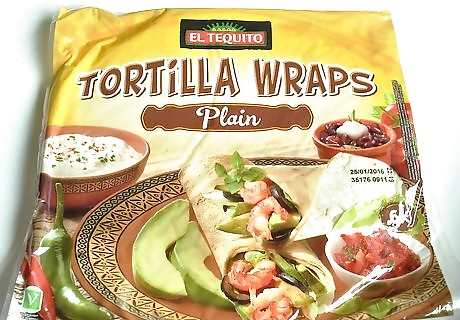
Find substitutes for traditional dough. If you'd instead not use a flour-based crust, there are other alternatives that you can try that are healthy options. Turn a whole-wheat tortilla into your crust if you want a thinner crust. Simply bake the tortilla on a pizza stone with toppings. Try a whole-wheat pita pocket that you bake. Bagels with the filling removed can also work. Simply scoop out the doughy insides of the bagel with a spoon or knife, leaving only the shell. Place your pizza ingredients inside of it as you would a pita pocket. Use quinoa. You could make your crust with a healthier grain like quinoa. Stay away from processed flour. Quinoa is a gluten-free whole grain.
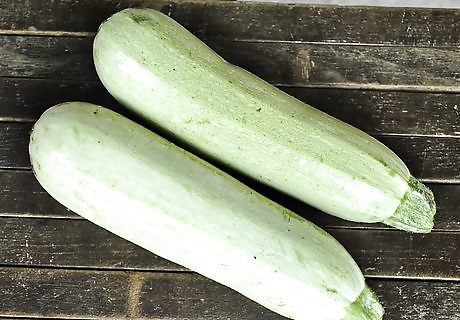
Make a crust out of vegetables. Vegetables give you a nutritional boost. The crust is no exception. It can be made entirely out of vegetables, reducing calories and boosting nutritional potential. Make cauliflower dough. Place cauliflower florets into a word processor and pulse, until you turn the vegetables into the consistency of warm sand. Microwave for several minutes. Drain. Place the pulsed vegetable on a kitchen towel, and remove all liquid. Add 1 teaspoon almond flour to bind the cauliflower, along with 1/3 cup of grated Parmesan and grated Mozzarella cheese each, 1/4 teaspoon salt, 1/2 teaspoon basil, 1/2 teaspoon oregano,1/2 teaspoon red pepper flakes, 1 egg, and 1/2 teaspoon grated garlic. Mold the mixture into balls and press on parchment paper into circle shapes. Bake for 10 minutes at 450 degrees Fahrenheit. To make zucchini dough, follow a similar process. Grate and drain it. Then add the same binding agents like mozzarella, almond meal, egg, Parmesan cheese, oregano, garlic powder, and salt. Forget dough completely and put your pizza toppings on top of a portabella mushroom (or eggplant).
Making Healthy Tomato Sauce
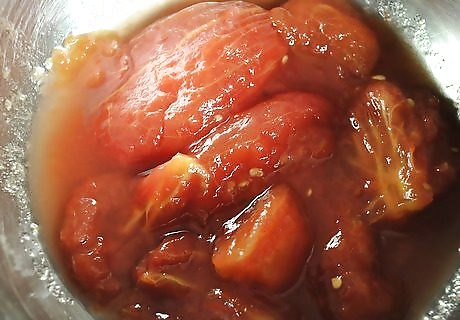
Boil the tomatoes. You will need 5 pounds of tomatoes as fresh as possible. However, if you don't have fresh tomatoes available in that quantity, you could substitute canned diced or whole tomatoes for the fresh tomatoes. Choose canned tomatoes without added spices. Carve an X into each tomato's bottom and put the tomatoes into a pot of boiling water. You are waiting for the tomato skins to loosen. Usually, this takes 5 to 20 minutes. Put the tomatoes in a bowl of iced water. Peel them. Then, chop the tomatoes. Red sauces are usually lower in calories than white sauces. Homemade sauce is better for you than canned sauces.
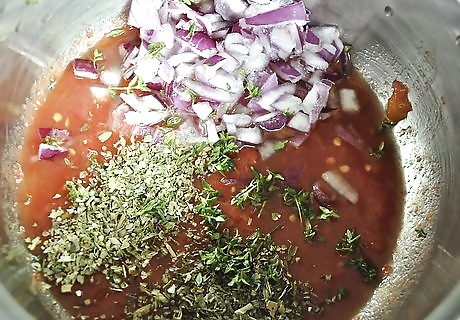
Mix the chopped tomatoes with herbs and onions. Take a Dutch oven and heat oil in it. Then, cook two medium onions and four cloves of garlic, add your tomatoes (and juice), and then herbs. Choose fresh herbs. It's recommended that you use 3/4 a teaspoon of basil, thyme, and oregano each. Some people put a teaspoon or two of sugar into the sauce but don't use sugar if you are trying for a healthier version. Boil and then simmer the sauce for 2 hours.
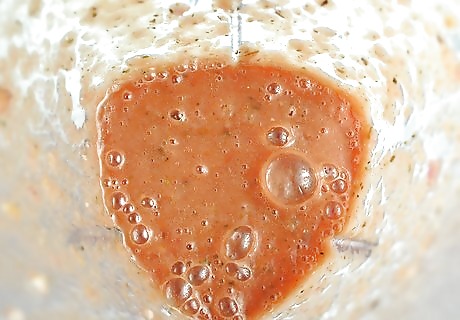
Complete the sauce. Put the sauce in a blender, and add 2 tablespoons of tomato paste. Blend until the sauce has a smooth consistency. However, you want to let the sauce cool before you blend it. If you blend hot sauce, you could make the top of the blender explode. Alternatively, you could blend smaller amounts of the sauce at a time, rather than fill the blender with hot sauce. You can also lift the lid to allow steam to escape before blending. The sauce can be safely refrigerated for three days or frozen for six months. Spread the sauce on your dough. The amount of sauce you should put on the pizza depends on its size. For a 16-inch pizza, you need about a cup of sauce. For an 8-inch pizza, 1/4 cup of sauce will do. For a 12-inch pizza, use 1/2 cup sauce with 1 tablespoon of sauce.
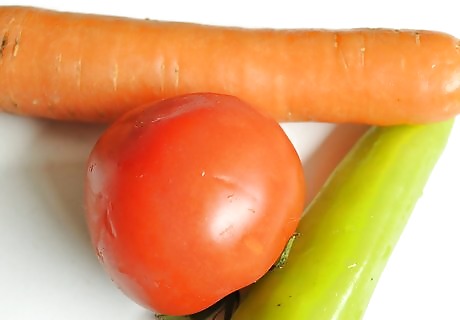
Use other alternatives for the fresh sauce. You could add vegetables to your tomato sauce. Possibilities include carrots, squash, peppers, or greens. You could make a Margherita pizza with fresh tomatoes, basil, and mozzarella cheese. Plum tomatoes can be a good choice for this kind of pizza, which is healthier for you because it never includes meat. Olive oil, garlic, or pesto are other healthier alternatives to tomato sauce. Brush olive oil over the crust and skip the sauce. There are many known health benefits to olive oil. However, high in fat, the type of fat included in olive oil is considered healthy dietary fat. It contains unsaturated and polyunsaturated fats (PUFAs) that can lower heart disease risk and cholesterol. This might be a better choice if you don't have fresh tomatoes because canned tomatoes can be loaded with sugar.
Adding Healthy Toppings
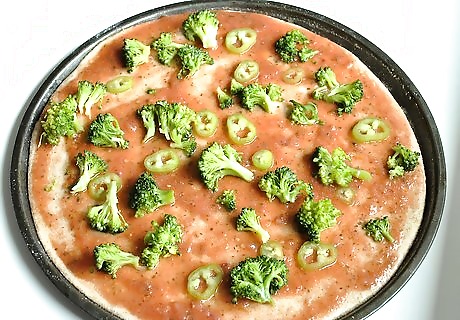
Add vegetables. Now that your pizza sauce is on the crust, add healthy toppings. Vegetables, especially green ones, are extremely low in calories and healthy for you. So, load your pizza on them. Spinach is one of the healthiest toppings you can put on a pizza. For example, it is loaded with vitamin K, which can prevent blood clots. Broccoli is another good choice. Try adding eggplant. As long as you don't fry it, it's a healthy choice. Create a salad on your pizza. Arugula with tomatoes and a little Parmesan cheese makes a delicious pizza salad. Plum tomatoes contain lycopene, which is an antioxidant that has many health benefits.
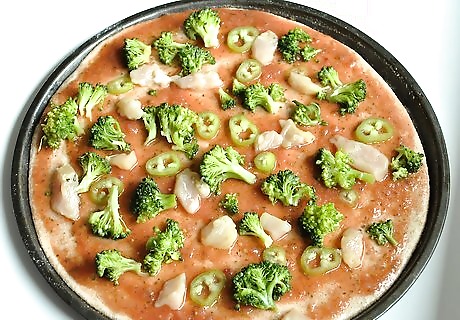
Choose healthier meats. Instead of the typical meats like sausage or pepperoni, try healthier, lower-calorie meat, even if you don't normally think of them on pizza. Recipes calling for turkey and part-skim cheese can clock in under 300 calories. Try putting shrimp and spinach on your pizza. Turkey bacon or chicken sausage gives the feel of a normal pizza without the fat. Some stores sell turkey pepperoni.
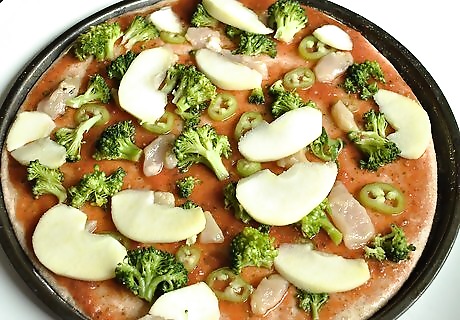
Try fruit. You don't have to limit pizza toppings to vegetables and meats. Although many people have tried pineapple on pizza before, experiment with other fruits. Put pears or apples on your pizza. Both fruits pair nicely with cheese. The good old staple pineapple will make you feel like you're eating the pizza you remember.

Use healthier cheese. If you must have cheese on your pizza, there are cheeses you can choose that are lower in calories and healthier. Parmesan cheese has fewer calories than other types of cheese. Choose cheese made out of low-fat or skim milk. Ricotta is an interesting choice. Goat cheese and feta have less oil in them. They are pungent cheeses with a lot of flavors. Be aware that feta does not melt on pizza like other cheeses. However, many recipes call for feta on pizza, especially Mediterranean styles. The cheese should be crumbled on the pizza and baked until golden brown. Skip cheese completely or only add it to half the pie. You can use online nutritional sites to check the number of calories in different kinds of cheeses.
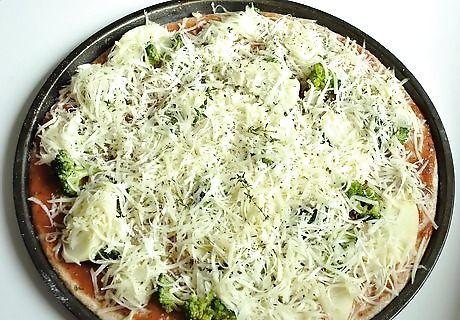
Use herbs and spices. If you load your sauce and pizza up with these, you will have so much flavor you might not miss the other more caloric items. Basil and rosemary are herbs that taste good on pizza. Try chili peppers or hot peppers. In addition to boosting your metabolism, they will kick your pizza's flavor.
Baking your Pizza

Preheat your oven. You want the oven to get hot. Set the oven to 500 degrees or your highest setting.Make a Healthy Pizza Step 16.jpg It usually takes a few minutes longer to cook pizzas with a lot of toppings. Coating your pizza pan or stone with crunched-up cornflakes or cornmeal will make the pie less likely to stick. Dust the pan with them, and they will provide a healthier way to eliminate stickiness than oil. You could coat the stone or pan lightly with olive oil.
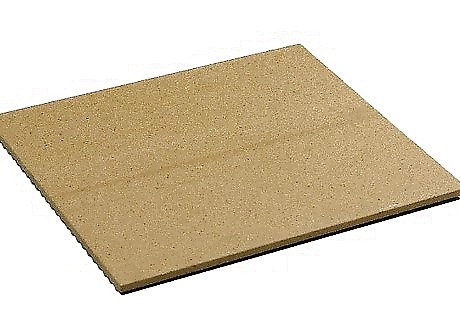
Use a pizza stone. Baking is a healthy way to cook, in general, and using a pizza stone is a healthy way to get a flavorful pizza. Place your completed pizza on the stone, and put it in the oven. You should preheat the pizza stone first at about 400 degrees by putting it in the oven with nothing on it for about an hour. Pizza stones will make your crust more crispy. This is especially important when using unusual thin crusts, like pita pockets or tortillas. You can also find pizza stones made out of steel or clay.
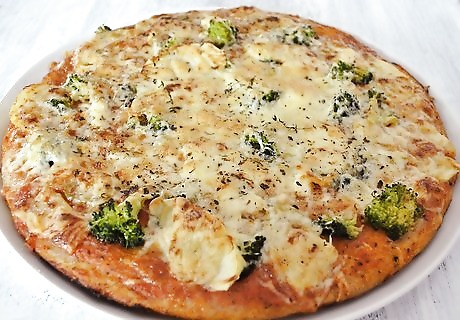
Bake the pizza. Ten to 14 minutes is usually long enough for the pizza to become crispy and golden. Remove it from the oven and serve it the right way. The longer you cook the dough, the crispier the crust will be.


















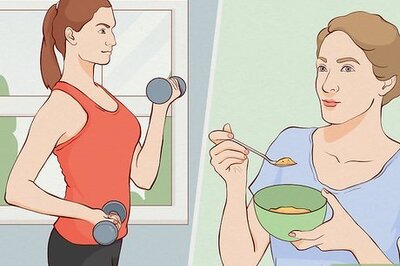

Comments
0 comment